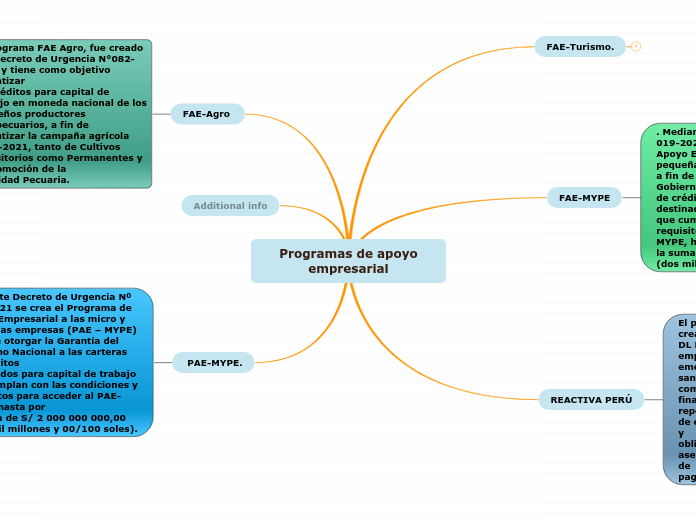Programas de apoyo empresarial
Rivers have always been essential for human life and settlement. A source for drinking, the source of food, and a way to transfer goods from one place to another. They are essential in the environment of rainforest and wetlands.
PAE-MYPE.
The Yangtze holds the title of Asia’s longest river. The Yangtze has a momentous place in China’s history and culture, providing some of the country’s most fertile land as well as some of its most artistically inspiring scenery.
Where the Mekong river runs, the land is incredibly verdant shaping one of the richest areas of biodiversity on the planet. Thousands of species call its shores and waters home. Long an essential trade route the Mekong passes through, or close to, some of the region’s most important cities, including Vientiane, Phnom Penh and Saigon.
Mediante Decreto de Urgencia Nº 019-2021 se crea el Programa de Apoyo Empresarial a las micro y
pequeñas empresas (PAE – MYPE) a fin de otorgar la Garantía del Gobierno Nacional a las carteras de créditos
destinados para capital de trabajo que cumplan con las condiciones y requisitos para acceder al PAE-MYPE, hasta por
la suma de S/ 2 000 000 000,00 (dos mil millones y 00/100 soles).
The Mekong is a trans-boundary river in Southeast Asia. Its estimated length is 4,350 km.
From the Tibetan Plateau, the river runs through China's Yunnan Province, Myanmar, Laos, Thailand, Cambodia, and Vietnam.
The Mekong rises as the Za Qu and soon becomes known as the Lancang (Lantsang) in the 'Three Rivers Source Area' on the Tibetan Plateau in the Sanjiangyuan National Nature Reserve. It approaches and empties into the sea through the Mekong Delta. Tributaries: Nam Khan, Tha, Nam Ou, Mun, Tonle Sap, Kok, Ruak.
FAE-Agro
The Volga is the longest river in Europe. The waters of the Volga are used to irrigate the steppe regions of southern Russia. Because of its importance in the country, the Volga has mythological status in Russia, and many iconic sites are found along its banks
The Danube is the second-longest river in Europe. Travelers can experience many of the river's sights by embarking on a cruise along its waterways. Danube River Cruises, which are offered by Viking Cruises, typically stop in Cologne, Budapest, Nuremberg, Belgrade and Krems. Following the river is a way to experience several Eastern European cities in one trip. Famous monuments, such as the Hungarian Parliament, have been erected on its coast.
El programa FAE Agro, fue creado por Decreto de Urgencia N°082-2020 y tiene como objetivo garantizar
los créditos para capital de trabajo en moneda nacional de los pequeños productores agropecuarios, a fin de
garantizar la campaña agrícola 2020-2021, tanto de Cultivos Transitorios como Permanentes y la Promoción de la
Actividad Pecuaria.
The Volga is the longest river in Europe with a catchment area of 1,350,000 square km.
Eleven of the twenty largest cities of Russia, including the capital, Moscow, are located in the Volga's drainage basin. Rising in the Valdai Hills 225 meters above sea level northwest of Moscow and about 320 km southeast of Saint Petersburg, the Volga heads east past Lake Sterzh, Tver, Dubna, Rybinsk, Yaroslavl, Nizhny Novgorod, and Kazan. From there it turns south, flows past Ulyanovsk, Tolyatti, Samara, Saratov, and Volgograd, and discharges into the Caspian Sea.
Tributaries: Kama, Oka, Vetluga, and Sura. The Volga Delta has a length of about 160 kilometers and includes as many as 500 channels and smaller rivers.
Actividad Pecuaria.
garantizar la campaña agrícola 2020-2021, tanto de Cultivos Transitorios como Permanentes y la Promoción de la
los créditos para capital de trabajo en moneda nacional de los pequeños productores agropecuarios, a fin de
El programa FAE Agro, fue creado por Decreto de Urgencia N°082-2020 y tiene como objetivo garantizar
Did you know?
The Volga freezes for most of its length during three months each year.
Search for other interesting facts about this river and add them here.
Tributaries
Volga River has 23 main tributaries. Type in several examples.
Tributary
Mouth
This is the place where it drains into a larger body of water - another river, a lake, the sea or the ocean.
Where is the mouth of the Volga River?
Source
The source of a river, also called headwaters, is the original point from which the river flows. Type in Volga's source.
Source of Volga River
Length
Try to state the length either in miles or in kilometers.
Length of Volga River
Which cities does the Volga flow through?
Volga flows through 11 out of the 20 most important cities in Russia. Type in a couple of these cities.
City
REACTIVA PERÚ
El programa Reactiva Perú, creado por el Estado mediante
DL N°1455, está dirigido a las empresas afectadas por la emergencia
sanitaria del COVID-19, y tiene como objetivo promover financiamiento de
reposición de capital de trabajo de empresas que enfrentan pagos y
obligaciones de corto plazo y así asegurar continuidad en la cadena de
pagos
FAE-MYPE
There are four major rivers in Africa: the Nile, the Zambezi, the Congo, and the Niger. The Nile is one of the longest rivers in the world.
The Zambezi's most noted feature is Victoria Falls. Other notable falls include the Chavuma Falls at the border between Zambia and Angola, and Ngonye Falls, near Sioma in Western Zambia.
. Mediante Decreto de Urgencia Nº 019-2021 se crea el Programa de Apoyo Empresarial a las micro y
pequeñas empresas (PAE – MYPE) a fin de otorgar la Garantía del Gobierno Nacional a las carteras de créditos
destinados para capital de trabajo que cumplan con las condiciones y requisitos para acceder al PAE-MYPE, hasta por
la suma de S/ 2 000 000 000,00 (dos mil millones y 00/100 soles).
The Nile, which is about 6,650 km long, covers eleven countries: Tanzania, Uganda, Rwanda, Burundi, the Democratic Republic of the Congo, Kenya, Ethiopia, Eritrea, South Sudan, Republic of the Sudan and Egypt.
It has two major tributaries, the White Nile and the Blue Nile. The White Nile is the headwaters and primary stream of the Nile. The White Nile is longer and rises in the Great Lakes region of central Africa, with the most distant source still undetermined but located in either Rwanda or Burundi. The two rivers meet just north of the Sudanese capital of Khartoum.
The northern section of the river flows north almost entirely through the Sudanese desert to Egypt, then ends in a large delta and flows into the Mediterranean Sea.
FAE-Turismo.
North America
In the 18th century, the river was the primary western boundary of the young United States, and since the country's expansion westward, the Mississippi River has been widely considered a convenient dividing line between the Eastern, Southern, Midwestern United States, and the Western United States.
South America
Amazon River, the greatest river of South America and the largest drainage system in the world in terms of the volume of its flow and the area of its basin.
---
Its source is Lake Itasca in northern Minnesota and it flows generally south for 2,320 miles (3,730 km) to the Mississippi River Delta in the Gulf of Mexico.
The main stem is entirely within the United States. Tributaries - St. Croix River, Wisconsin River, Rock River, Illinois River, Kaskaskia River, Ohio River, Minnesota River, Des Moines River, Missouri River, White River, Arkansas River.
The river either borders or passes through the states of Minnesota, Wisconsin, Iowa, Illinois, Missouri, Kentucky, Tennessee, Arkansas, Mississippi, and Louisiana.
Cubre como máximo el monto equivalente a cuatro (4) meses el nivel de venta promedio del año 2019, según los
registros de la SUNAT. Alternativamente, también se puede considerar tres (3) veces el promedio mensual de deuda
de capital de trabajo registrado por la MYPE, en el año 2019, en la ESF o COOPAC que le otorga el crédito.
Additional info
El FAE Turismo fue creado por Decreto de Urgencia N°076-2020 con el objetivo de promover el
financiamiento de las micro y pequeñas empresas (MYPE) del sector turismo, a través de créditos para capital de
trabajo que realizan actividades de establecimientos de hospedaje, transporte interprovincial terrestre de pasajeros,
transporte turístico, agencias de viajes y turismo, restaurantes, actividades de esparcimiento, organización de
congresos, convenciones y eventos, guiado turístico, y producción y comercialización de artesanías.









